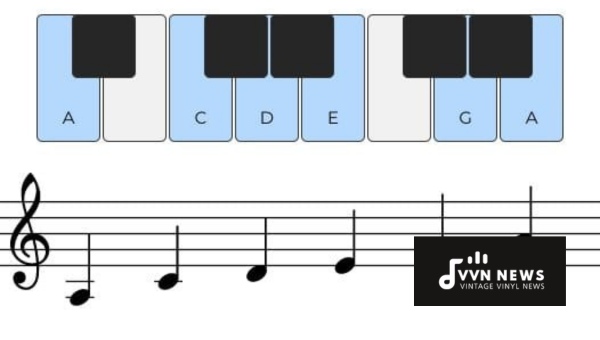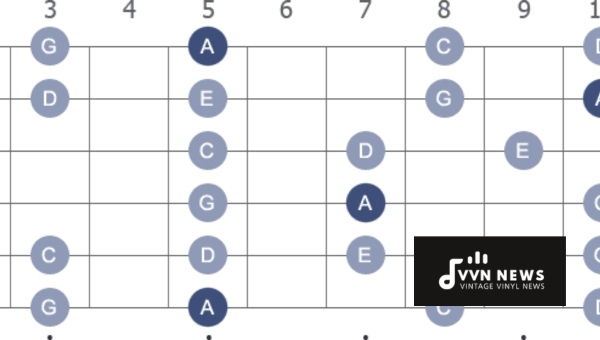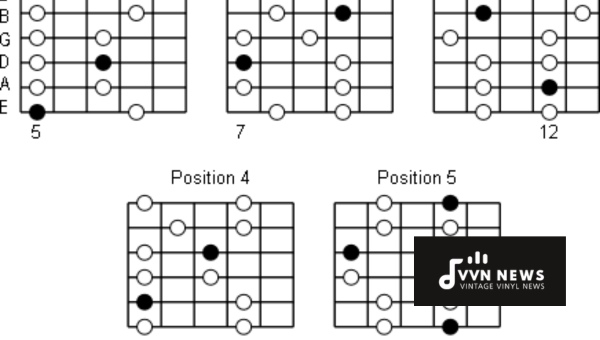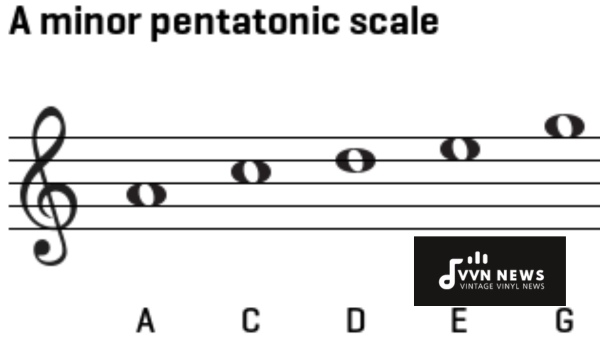Discover the profound beauty and simplicity of the power-packed A minor pentatonic scale.
This unique scale, with its wide influence in a spectrum of musical genres, is so straightforward that even complete beginners can grasp it easily.
Just as a small seed can grow into a tall tree, so too can understanding this scale lead to great strides in your musical journey.
Imagine using just five notes to play some of the most heart-swing tunes ever composed!
You will be surprised how much you can do with the A minor pentatonic scale at your fingertips.
Its versatility ranges from blues and rock to jazz and pop; it’s almost like having mighty musical superpowers at your disposal. Can music get any more magical than this? Let’s find out.
Components of the A Minor Pentatonic Scale
The A minor pentatonic scale comprises five distinct notes: A, C, D, E, and G. It is said to be a ‘minor’ pentatonic due to the inclusion of a minor (or flattened) third note; in this case, the “C”.
The appeal of this scale lies in its uncluttered sound pattern, which incredibly brings out your solo melodies or improvisations like no other.
If you are wondering where to start, remember: The pentatonic scale noticeably begins and ends on A.
This appealing musical structure spreads its charm in forming a countless number of memorable tunes globally!
Guidelines for Mastering the A Minor Pentatonic Scale

Understanding how to formulate the minor pentatonic scale can take your musical expertise to a new height.
It’s a simple process that involves understanding the construction of the scale and practicing it till it becomes second nature. Here are some crucial steps you can follow:
- Identify the notes: The A minor pentatonic scale consists of five notes: A, C, D, E, and G. Notably, it begins and ends with an ‘A’ note.
- Learn the pattern: This scale follows a specific pattern – minor, minor third, major second, major second, minor third, and major second (represented in terms of intervals).
- Transpose: Once you’ve grasped this pattern well in ‘A,’ try transposing it to other keys too.
Remember; practice makes perfect! Spend time familiarizing yourself with this scale on your instrument of choice.
Also Read: F Minor Blues Scale [Experiment With This Dark & Moody Key]
Describe the shapes of the A Minor Pentatonic Scale.
Mastering the five shapes of the A Minor Pentatonic scale can be quite a journey, but it’s a trip worth taking.
Remember to focus not just on learning these shapes, but also on associating each shape with its unique sound.
The Five Patterns or Shapes

The A Minor Pentatonic Scale, like all pentatonic scales, comprises five notes that repeat in a particular pattern across the fretboard.
These five patterns or shapes are linked to a sequence of finger placements. Each pattern represents a region on the neck where those notes can be played.
The Home Box
The first and most commonly used shape is often called the ‘Home Box.’
This pattern focuses on the 5th fret and is typically regarded as many guitarists’ go-to shape when starting with pentatonic scales.
Sliding Up
The second shape starts from the 8th fret and slides up towards the top of the neck.
It might take some practice to get accustomed to this positioning, but it offers a melodic richness that you’ll undoubtedly enjoy exploring.
The Dodgy Stretch
The third shape might feel awkward initially due to its wider stretches (between 10th and 12th frets), particularly for those of us not blessed with long fingers! Don’t worry; you’ll get the hang of it quicker than you think.
Moving Downwards
The fourth pattern moves back down closer to the “home box,” but at upper string levels, around the second and fifth frets.
It’s an excellent addition for solos that require descending note sequences.
The Final Frontier
Lastly, our fifth shape combines elements from other designs with added complexity for flavorsome riffs and licks between the first and third frets.
Its uniqueness brings a fun challenge for honing your guitar skills further.
Remember, the trick to mastering these shapes is not just memorization, but also recognition of each scale’s particular sound and how to move through them fluidly.
May this exploration through music theory spark a riveting musical journey for you! Happy strumming.
Also Read: C Minor Blues Scale [Guitar Guide For Passionate Players]
Benefits of Learning the A Minor Pentatonic Scale?
By embracing the A minor pentatonic scale, you unlock limitless potential benefits in your musical journey.
Whether you’re a newbie or a seasoned player, this scale will always offer something valuable.
Ease of Learning
The A minor pentatonic scale is often seen as an optimal starting point for many beginners.
Equipped with just five notes – A, C, D, E, and G – it’s simpler than most scales. This lack of complexity allows for undemanding memorization and smooth progression.
Impressive Versatility
Its great versatility cannot be overstated. Ever wondered how your favorite rock or blues tunes captivate your heart? That can probably be credited to the magic of this sensational scale.
The magical mix allows you to venture into various genres like pop, jazz, and rock – making it an all-rounder in your musical arsenal.
Unleash Creativity
Working within the constraints of five notes might seem limiting at first.
This simplicity allows you to focus more on the nature of how these notes interplay – rhythm, dynamics, phrasing e.t.c., sparking creativity.
Highly Compatible
Matchlessly compatible with many chord progressions, it’s that cherished tool that works harmoniously across multiple contexts – Just like a master key!
Adopting this scale accelerates your expansion into related scales such as blues or diatonic scales.
This growth paves the way for an enriched understanding of music theory – upgrading your skillset and boosting confidence.
Also Read: E Flat Minor Pentatonic Scale [Master This Key With Our Guide]
What are the Related Scales to A Minor Pentatonic

Before we delve into the related scales, let’s have a quick run through the notes in A minor pentatonic scale: A, C, D, E, and G.
Now, let’s look at how these notes connect back to other important scales.
The Natural Minor Scale or Aeolian mode
The first related scale is the natural minor scale. In terms of A minor, this scale incorporates the same notes as in A minor pentatonic with the addition of two others: B and F.
Thus, forming the pattern: A, B, C, D, E, F, and G. Although it may seem like a small variance to add these two notes, they can greatly impact your composition’s emotional color and harmonic structure.
The Major Scale or Ionian mode
Moving on from there, we explore another related major scale: C Major. This key offers all seven natural notes used in Western music.
What makes it different from A minor pentatonic is its inclusion of B and F. This renders its pattern: C, D, E, F, G A, and B.
You’ll notice that both scales contain more notes; however, their similarity to A minor pentatonic underscores the foundational role that this five-note powerpack plays in our music.
Beyond Typical Scales
The road doesn’t stop at major and natural minor scales. You will find compatibility with other modes including Dorian mode (D), etc., should you fancy exploring exotic tones for your music escapade.
Taking inspiration from an encompassing variety of musical structures further reinforces what we can do with our A minor pentatonic scale competencies.
Now take these insights to your instruments right away! Play around with these supplementary scales which heighten your existing knowledge of the A minor pentatonic scale.
Making Backing Tracks Work for A Minor Pentatonic Scale
Backtracks provide rhythm and harmonic support that can enhance your practice with A Minor Pentatonic scale.
They are a fun and effective way to improve your rhythm, soloing, and improvisation skills. Here are some key points to effectively using backtracks:
Select the Right Backing Track:
Firstly, ensure the track is in the key of A minor. It doesn’t matter the genre – blues, rock, country, etc., as long as it’s in A minor or its relative major, C major. Choose a track with a clear beat you can easily follow at first.
Practice Scales over the Backing Track:
Once you’ve chosen the correct track; play along with it on repeat. To start with, try playing simple scale sequences like ascending and descending runs. Eventually, venture to more complex rhythmic variations.
Employ Improvisation Techniques:
Work on improvisation techniques such as bends, slides, and power chords. Play them alongside your backtracks in different combinations.
Experiment!
Don’t be afraid to test yourself beyond what you’re comfortable with. Mix up melodies and rhythms; explore different scales like blues or Dorian over the track.
For maximum progress with A Minor Pentatonic scales or any musical undertaking, the rule of thumb is methodical practice.
Combine that with quality backing tracks, and your road toward musical proficiency will be a rewarding journey.
Also Read: F Minor Pentatonic Scale [Impact Your Melodies & Solos]
Implications of Ear Training on Grasping the A Minor Pentatonic Scale

One can’t underestimate the significant role that ear training plays when it comes to mastering, internalizing, and improvising over the A Minor Pentatonic Scale.
It’s all about perceiving, interpreting, and applying your sense of hearing to musical patterns.
Actively Listening
Listening allows us to draw parallels between what we hear and how it is applied to our musical instrument.
The more familiar your ears become with the sounds and intervals within the A Minor Pentatonic Scale, the more creative you become in using them.
Playing By Ear
This is another essential aspect of ear training. Once you hone this skill, you’ll be able to replicate melodies heard in songs onto your musical instrument using solely the A Minor Pentatonic Scale.
Improvisation
Improvising represents one of the ultimate benefits of ear training. You not only play what you hear but also add a unique touch by inventing phrases via applying note choices from the A Minor Pentatonic Scale.
Ear training profoundly entertains strong correlations with our ability to grasp scales like the A minor pentatonic scale giving musicians their much-needed edge.
Songs That Utilize the A Minor Pentatonic Scale
A vast array of renowned songs in various genres have made use of the A Minor Pentatonic scale.
This characteristic assists them in creating relatable and heart-touching melodies, making them seem both familiar and novel simultaneously.
1. “Stairway to Heaven” by ‘Led Zeppelin’
Guitar legend Jimmy Page ventured into the realm of folklore for this monumental classic.
The song’s intro is an iconic example of how A Minor Pentatonic scale contributes to a piece’s overall mood.
2. “Hey Joe” by ‘Jimi Hendrix’
This profound track does an extraordinary job showcasing Hendrix’s ability to manipulate the A Minor Pentatonic scale creatively.
From the intro riff to the solos, Hendrix weaves a rich tapestry with just five notes.
3. “Comfortably Numb” by ‘Pink Floyd’
Earth-shattering guitar solos in this anthemic track have been crafted using none other than our beloved A Minor Pentatonic scale.
Gilmour’s expressive phrasing makes every note speak volumes, striking deep within one’s soul.
Embrace the understated elegance of the A Minor Pentatonic Scale & watch as it turns into your magic wand—be it for experimentation, improvisation, or simply crafting the soundtrack to your life.
Also Read: E Flat Minor Blues Scale [Infuse Your Tunes With Moody Blues]
FAQs About the A Minor Pentatonic Scale
What is the A Minor Pentatonic Scale?
The A minor pentatonic scale is a simple, five-note scale that is a subset of the A minor scale. It’s popular in various music genres like rock, blues, and jazz.
Why is the A Minor Pentatonic Scale so popular?
Because of its simplicity and versatility. Even beginners find it easy to work with, and it can be adapted to various music genres.
Can I play an entire song using just the A Minor Pentatonic Scale?
Absolutely! Many popular songs have been composed using just this five-note scale.
Are there different shapes in the A Minor Pentatonic Scale?
Yes, there are 5 common shapes or positions used in playing the A minor pentatonic scale on a guitar.
How does knowing the A Minor Pentatonic Scale help improve my musical abilities?
Understanding and mastering this basic five-note scale can significantly enhance your improvisation skills and give you a solid grounding in musical theory.
Conclusion
In essence, comprehending the A Minor Pentatonic Scale is like receiving a key that opens doors to endless musical possibilities.
This versatile, five-toned scale is your ticket to achieving greater depth and breadth in your musical repertoire.
So, what are you waiting for? Grab your instrument and get started with the A Minor Pentatonic Scale today!
Remember to take it slow initially, focus on mastering each note, and gradually work on speed.








